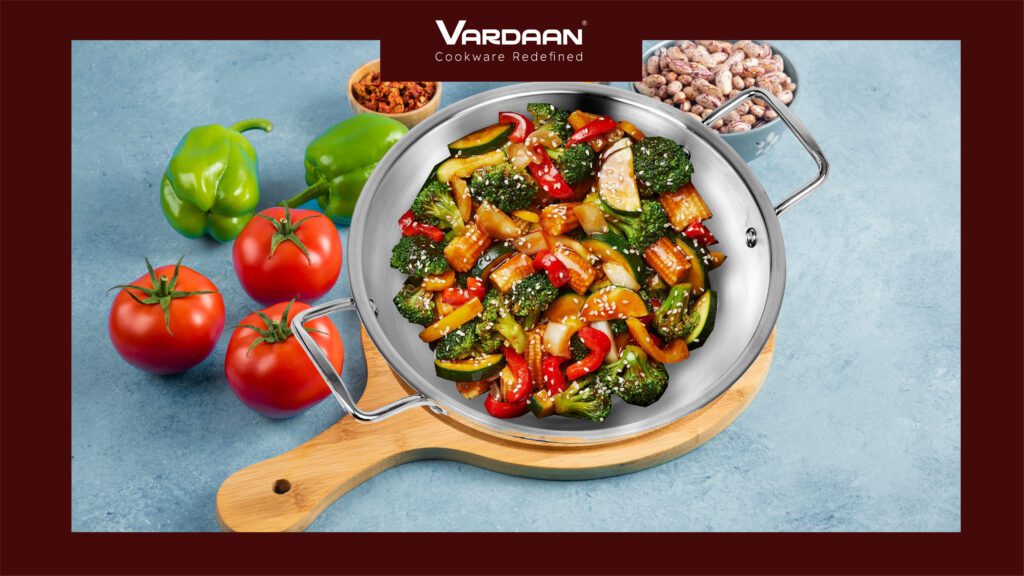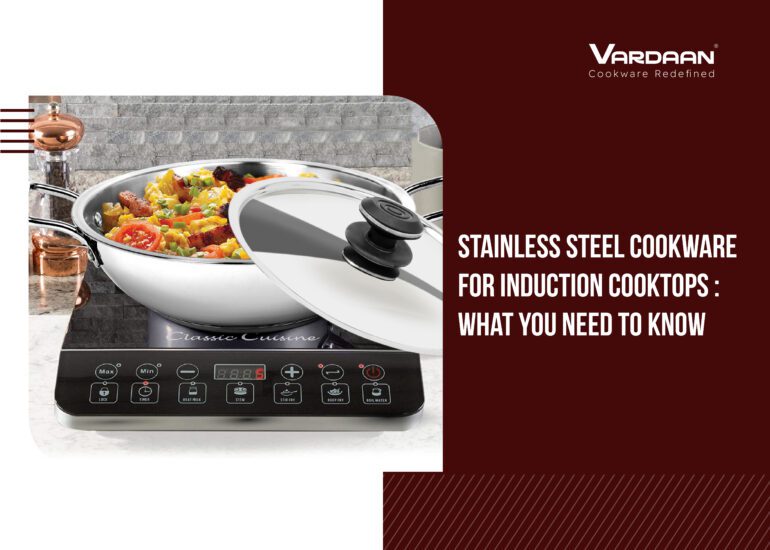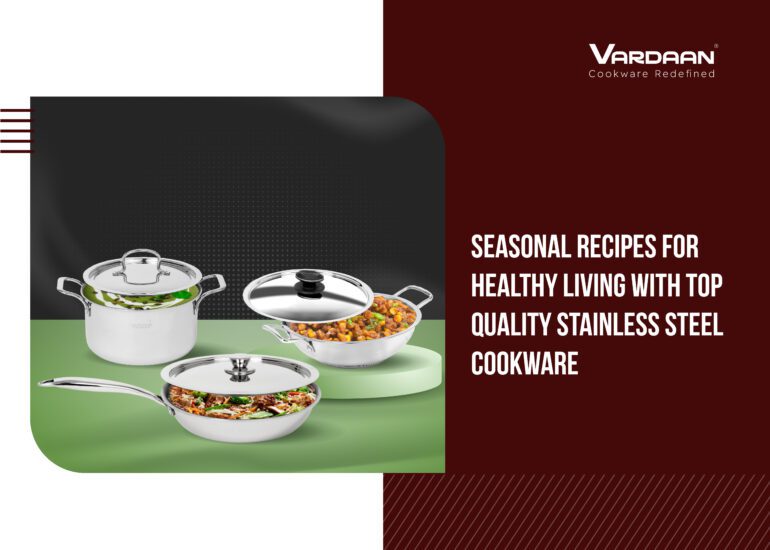In Indian kitchens, where traditions hold a special place, there is one cooking utensil that has withstood the test of time: the stainless steel kadhai. This unassuming yet essential piece of cookware has been an integral part of Indian households for generations, transcending regional boundaries and cultural differences. Its timeless presence in the kitchen speaks volumes about its cultural significance and the deep-rooted traditions it embodies.
The stainless steel kadhai, with its rounded bottom, sturdy handles, and wide surface area, is more than just a cooking vessel. It is a symbol of warmth, togetherness, and the art of culinary mastery passed down through generations. As the clanging sound of the kadhai hitting the stove resonates in Indian households, it evokes a sense of nostalgia, taking us back to the cherished moments spent with loved ones in the kitchen.
This traditional utensil holds immense practicality, as it is versatile enough to handle a wide range of cooking techniques. From stir-frying vegetables to deep-frying pakoras, from simmering curries to preparing aromatic biryanis, the stainless steel kadhai can do it all. Its ability to distribute heat evenly and retain it for extended periods ensures that flavors are locked in and dishes are cooked to perfection.
Beyond its functional aspects, the stainless steel kadhai represents the cultural fabric of India. It embodies the values of sharing, hospitality, and the joy of cooking for others. It is a vessel that brings families together, as they gather around the kitchen, sharing stories, laughter, and delectable meals prepared with love and care.
As we delve deeper into the cultural significance of the stainless steel kadhai, we will uncover its historical roots, explore the rituals associated with its usage, and understand why it continues to be an indispensable part of Indian kitchens today. Join us on this enlightening journey as we celebrate the timeless tradition of the stainless steel kadhai in Indian culinary heritage.
History of the humble stainless steel kadhai.
The history of the Stainless Steel Kadhai in India dates back several centuries. Traditionally, Indian kitchens used utensils made of materials like brass and iron. However, with the advent of stainless steel, a new era began. Stainless steel kadhai gained popularity due to its durability, corrosion resistance, and hygienic properties. They were a significant improvement over the earlier materials and became a preferred choice for cooking. Stainless steel kadhai revolutionized Indian kitchens, offering a versatile and reliable cookware option. Today, they are an iconic and essential utensil in every Indian household, embodying the fusion of tradition and modernity in culinary practices.
Rituals using Stainless steel kadhai.
In Indian households, the usage of Stainless Steel Kadhai is often accompanied by various rituals that add a cultural touch to the cooking experience. These rituals reflect the significance of the kadhai and the importance of food in Indian traditions. Here are a few rituals associated with the usage of Stainless Steel Kadhai in India:
- Prayers and Blessings: Before using a new Stainless Steel Kadhai for the first time, it is common for people to perform a small prayer or seek blessings from elders. This ritual is believed to bring good luck and positive energy to the utensil and the food cooked in it.
- Seasoning the Kadhai: Seasoning the Stainless Steel Kadhai involves heating oil or ghee in the kadhai and then coating the inner surface with it. This process helps in preventing food from sticking to the kadhai and enhances its longevity. It is a traditional practice followed to prepare the kadhai for optimal cooking performance.
- Offering Prasad: During festive occasions or religious ceremonies, the Stainless Steel Kadhai plays a crucial role in preparing prasad (sacred offering). It is believed that cooking prasad in the kadhai and serving it to deities brings blessings and sanctity to the offering.
- Sharing Food: The act of cooking in a Stainless Steel Kadhai often involves large quantities of food, making it ideal for communal cooking and sharing. In Indian culture, sharing food is considered auspicious and a way of fostering unity, love, and generosity among family members and guests.
- Passing Down the Tradition: Stainless Steel Kadhais are often treasured heirlooms passed down through generations. Handing over a well-seasoned kadhai to the next generation is symbolic of preserving family traditions, culinary skills, and the cultural heritage associated with cooking in Indian households.
These rituals surrounding the usage of Stainless Steel Kadhais not only add a sense of reverence but also strengthen the cultural bond and emotional connection between generations, making every meal a cherished experience.

The importance of Stainless steel cookware in the Indian household.
The stainless steel kadhai continues to be an indispensable part of Indian kitchens today due to several reasons:
- Durability: Stainless steel kadhai is known for its durability and longevity. It can withstand high temperatures, heavy usage, and regular wear and tear, making it a reliable and long-lasting cookware option for Indian cooking styles, which often involve intense heat and stirring.
- Versatility: The stainless steel kadhai offers versatility in cooking. Its wide and deep shape allows for various cooking techniques like stir-frying, sautéing, deep-frying, simmering, and even making gravies and curries. It can accommodate large quantities of ingredients and provides ample space for even heat distribution.
- Hygiene and Safety: Stainless steel is a non-reactive material, which means it does not leach harmful chemicals into the food. It is easy to clean, resistant to stains, and does not retain flavors or odors from previous cooking sessions. This makes stainless steel kadhai a hygienic and safe choice for everyday cooking.
- Heat Distribution: Stainless steel kadhai distributes heat evenly across its surface, ensuring that the food is cooked uniformly. This feature helps in achieving better flavors, textures, and consistent results in various recipes.
- Modern Design: Stainless steel kadhais have evolved in terms of design and functionality. They often come with ergonomic handles, sturdy lids, and additional features like heat-resistant knobs or insulated handles, making them user-friendly and convenient to handle during cooking.
- Cultural Connection: The stainless steel kadhai holds a deep cultural connection in Indian households. It represents tradition, family bonding, and the joy of cooking together. It is a symbol of heritage and nostalgia, reminding people of the flavors and aromas that have been passed down through generations.
Considering these factors, the stainless steel kadhai continues to be favored by Indian households for its reliability, versatility, hygiene, and cultural significance. It remains an essential tool in Indian kitchens, preserving time-honored cooking practices and bringing families together over delicious meals.
Hence…….
In conclusion, the stainless steel kadhai stands as a timeless tradition in Indian kitchens, reflecting its deep-rooted cultural significance. Alongside this rich heritage, Vardaan Cookware’s stainless steel cookware emerges as a reliable and trusted companion in the culinary journey. With their durable construction, versatility, and adherence to traditional values, Vardaan Cookware’s stainless steel utensils embody the essence of Indian cooking. By embracing these meticulously crafted cookware pieces, we not only honor cherished traditions but also elevate our culinary experiences. As we continue to celebrate the cultural legacy of the stainless steel kadhai, Vardaan Cookware remains a symbol of quality and a catalyst for remarkable gastronomic creations.




